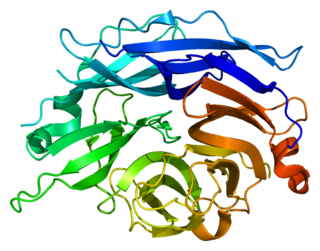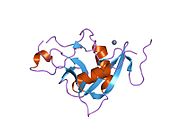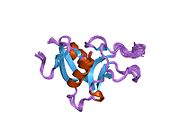
C-jun-amino-terminal kinase-interacting protein 1 is an enzyme that in humans is encoded by the MAPK8IP1 gene.

Somatostatin receptor type 5 is a protein that in humans is encoded by the SSTR5 gene.

C-type lectin domain family 4 member M is a protein that in humans is encoded by the CLEC4M gene. CLEC4M has also been designated as CD299.

Frizzled-5(Fz-5) is a protein that in humans is encoded by the FZD5 gene.

Pancreatic Stone Protein (PSP), also known as Lithostathine-1-alphaislet cells regeneration factor (ICRF) or islet of Langerhans regenerating protein (REG) is a protein that in humans is encoded by the REG1A gene as a single polypeptide of 144 amino acids further cleaved by trypsin to produce a 133 amino acid protein that is O-linked glycosylated on threonine 27. This protein is a type I subclass member of the Regenerating protein family. The Reg protein family is a multi protein family grouped into four subclasses, types I, II, III and IV based on the primary structures of the proteins. Reg family members REG1B, REGL, PAP and this gene are tandemly clustered on chromosome 2p12 and may have arisen from the same ancestral gene by gene duplication. The PSP is mostly produced in Human by the acinar cells of the pancreas and is secreted in the duodenum by the same pathway that pancreatic exocrine enzymes. It has C-terminal C-type lectin domain whose binding partner is currently unknown.

Glucosidase 2 subunit beta is an enzyme that in humans is encoded by the PRKCSH gene.

Lithostathine-1-beta is a protein that in humans is encoded by the REG1B gene.

Nuclear protein 1 is a protein that in humans is encoded by the NUPR1 gene.

40S ribosomal protein S9 is a protein that in humans is encoded by the RPS9 gene.

60S ribosomal protein L28 is a protein that in humans is encoded by the RPL28 gene.

40S ribosomal protein S5 is a ribosomal subunit of the Eukaryotic ribosome (80S) complex. In humans it is encoded by the RPS5 gene.

60S ribosomal protein L21 is a protein that in humans is encoded by the RPL21 gene.

Homeobox protein CDX-1 is a protein in humans that is encoded by the CDX1 gene. CDX1 is expressed in the developing endoderm and its expression persists in the intestine throughout adulthood. CDX1 protein expression varies along the intestine, with high expression in intestinal crypts and diminishing expression along intestinal villi.

Regenerating islet-derived protein 4 is a protein that in humans is encoded by the REG4 gene.

Tumor protein p53-inducible nuclear protein 1 is a protein that in humans is encoded by the TP53INP1 gene. In mice this protein is also called TRP53INP1 and is encoded by the Trp53inp1 gene. The protein is also referred to as SIP or "stress inducible protein"

Vesicular inhibitory amino acid transporter is a protein that in humans is encoded by the SLC32A1 gene.

Sialidase-2 is an enzyme that in humans is encoded by the NEU2 gene.

Transmembrane protein 49 is a protein that in humans is encoded by the TMEM49 gene.

Regenerating islet-derived protein 3 gamma is a protein that in humans is encoded by the REG3G gene.
The regenerating protein family often abbreviated as Reg family are a group of small secretory proteins that are involved in the proliferation and differentiation of diverse cell types. In addition they are important in protecting cells from death caused by damage or inflammation.




















